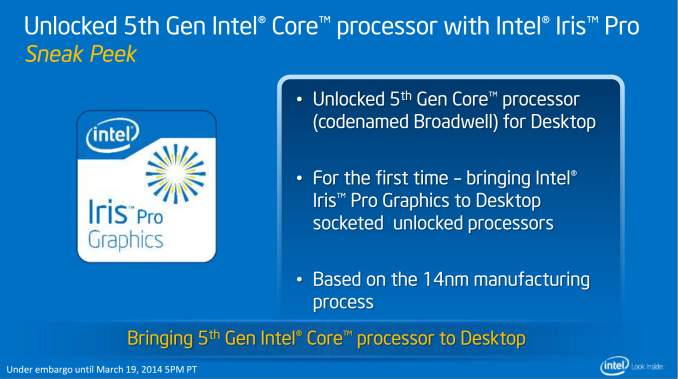Intel 2014 Enthusiast Processors: New Unlocked Iris Pro CPU Coming to Broadwell
by Ian Cutress on March 19, 2014 8:00 PM EST
In a somewhat uncharacteristic turn from Intel, we were hooked up and loaded in to a press conference call this week regarding the announcement of some exciting new products coming to market. The purpose of the press conference call was to explain some new technologies coming to the scene, as well as Intel stating that they are listening to their userbase, including enthusiasts. As an enthusiast, these announcements make me very excited, although they do produce more questions than they answer.
The announcement is the introduction of a socketed version of Iris Pro, coming to Intel’s Broadwell platform.
So the first big thing here is Iris Pro coming to a socketed platform, which we have requested since the release of Crystal Well BGA parts in devices like the Apple iMac and GIGABYTE BRIX Pro. This should allow users to build SFF socketed systems with Intel’s highest end integrated graphics. What was not mentioned was if this will be a new Iris Pro for Broadwell, or just another Iris Pro HD 5200 part with a Broadwell CPU.
The second big part from this one announcement is that the CPU is said to come fully unlocked. This should mean that the CPU multiplier, CPU strap, memory and the uncore should be fully adjustable - Intel have told us that this part will have a similar set of overclocking tools as the other unlocked parts. Intel are not disclosing what the limits are or what is expected, and equally no information regarding the release date, whether this CPU will come with the Broadwell CPU launch or at a later date afterwards.










64 Comments
View All Comments
errorr - Thursday, March 20, 2014 - link
It is called synesis or notional agreement and is a regular feature of Br. English and is perfectly grammatical in American English as well although in America it is a more explicit emphasis on the collective nature it the noun. Usually in Am. English you will see the mass noun become a compound noun with the addition of a word like members or employees &c. if you want to use notional agreement.mikk - Thursday, March 20, 2014 - link
Of course it's not HD 5200, Broadwell gets a completely new GPU.1Angelreloaded - Thursday, March 20, 2014 - link
NO, just no, stop with the damn graphics already on the CPU die, I can understand this for OEM applications, but this does not belong in mid to higher end consumer products. A lot of are made to pay for this poor video solution that we never use, and most likely never will ever. The stupidity of the industry in the last 10 years has become a contest of who can price gouge, selling individual units at inflated costs to basically price fix the entire market with micro improvements, and holding on to outdated poor standards that have come to become a stifling agent.MrSpadge - Thursday, March 20, 2014 - link
Guess what? You'll pay the same for an Intel CPU regardless of it containing a GPU or not. Just look at the prices of those socket 1150 Xeons with and without GPUs.unixbrain - Thursday, March 20, 2014 - link
Actually, the lowest price for the consumer involves leaving the integrated graphics in place. Despite what the AnandTech comment section might lead you to believe, the vast majority of Intel's customers do not want or need discrete graphics, and your preference is the minority. Maybe not the minority of enthusiasts, but the minority nonetheless.Producing separate versions of each core without the GPU just for you would almost certainly involve charging MORE because of the additional research, engineering, and manufacturing lines that would be required for these separate, minority-oriented products.
Also I am very sorry that you are disappointed with the iterative development process. I happen to think we've (cumulatively) seen some pretty drastic improvement in the last decade.
larkhon - Thursday, March 20, 2014 - link
seems pretty pointless to invest in iGPU in high end CPUs, but I think with new technologies like HSA we might be able to maximize the usage of the whole CPU/GPU. Now question is which standard is going to be the most popular and/or supported by Intel.stephenbrooks - Thursday, March 20, 2014 - link
Actually it's not *that* daft. If you imagine an engineer who does mostly CPU-heavy work but still wants to see it rendered in 3D, they probably don't need enough GPU horsepower to run Skyrim on Ultra settings, but they need more than the emulation you get with no GPU at all. Hence these high-end CPUs with mid-end iGPUs are a cost-effective way of getting that (assuming the company is being sensible and avoiding the Xeon price gouge).jimjamjamie - Thursday, July 10, 2014 - link
An i7-broadwell w/Iris Pro w/16GB RAM and a fast SSD sounds like a sweet CAD/3D workstation. On top of that you could probably get some Minecraft or TF2 on the go with £0 spent on a graphics card.just4U - Friday, March 21, 2014 - link
It will be interesting to see what they come up with here. Any Ideas (or rough guesses..) on launch dates? I saw no reason to upgrade to the 3x/4x series by Intel but something like this will be a lot more tempting.HardwareDufus - Friday, March 21, 2014 - link
Cool. Looks like I'll be getting an I7-5770k for my next mini-ITX build.